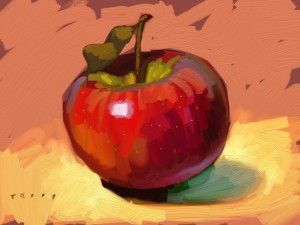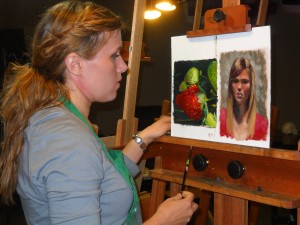We are Artists Because IT USED TO BE FUN!

I became and Artist cuz art is fun.
I want to start this by asking you, how did you get into art? What made you start producing art? Was it just for fun? Were you just a kid? Did you get into art because people asked you to draw things for them? I honestly doubt that you got into art because other people asked you to. Most of us got into art to make cool stuff and because it was fun and fulfilling.
There is much amazing stuff out there, and we looked out at it and decided we wanted to make our own and show it to the world.
Do you want to be an Illustrator, an Artist, or an Employee?

Art is fun.
Yet so many artists who have spent so long learning, and practicing get to a certain point, like when they’re about to finish school, and they start thinking about getting out of school, becoming an Artist, an illustrator, or just thinking about how to make money with their art skills.
After that all of a sudden we want to get hired. So we can get paid. So we can eat. We want to be employees. We start looking for someone else to tell us what to do (or draw) so we can make a living, and so we can eat.
We get asked to draw something that isn’t fun or we get asked to do something that takes away from our vision.
What can I do To Make Money as an Artist?
I don’t want to discourage you, there is nothing wrong with working with and helping other people. I want to help open your mind to other possibilities.
It started with students across the country, and now it’s students all over the world. People want to be hired.
The main thing I am asked is, “what can I draw to make money?” I think it’s backwards, is that why we became artist? I’m not saying it’s inherently wrong, but it’s not why we started.
I’m in a position now that I can pick and choose. I’ve put in a lot of work that I ended up hating but I’ve also put a lot of work into my children’s books that I’ve really enjoyed, and I enjoyed the people I’ve worked with.
THERE ARE A LOT OF OPTIONS.
But is that the only way or are there other things that we can do? Have you ever thought that musicians, authors, actors, videographers, and gallery artists are more entrepreneurial than illustrators. Think about that, are they?
What is wrong with Illustrators. And this is a generalization. Musicians move to Austin, or Nashville, or they record in a friend’s house, and now with the internet a lot of them are starting their own YouTube channels. Comedians are starting their own YouTube channels. Actors move to Hollywood or start YouTube channels, Gallery-Artists make something and try to get someone to buy it. Writers write something and hope publishers buy it, or they publish it on Amazon and sell it directly. Like Amanda Hopkins.
Illustrators Want to be hired, commissioned, or just get a job.
What’s the difference between us Illustrators, and all the other artists? Ask yourself and try to answer that question. A graphic designer decided to publish his own small books. I have a friend who owns a graphic design studio, and we first started working together about ten, fifteen years ago. And he would hire me, he was getting contracts from Children’s book publishers, and he would hire me to do covers and inside spreads.
A couple years ago he hired me to do some work for a children’s book with a publisher I had never heard of before, why because it was new, it also happened to be him or his publishing company. He decided ‘you know what, I can make one of these myself’. And he’s still publishing books, and even some e-books online.
The Internet has Been a Real Game Changer.
If you are a teenager or in your mid-twenties, you probably grew up with the internet. Not knowing life without it. I wonder if the internet is more impressive to me someone who lived without it. I can’t speak for someone who lived without cars, or plains. But I worked without the internet. I don’t want to just assume that I appreciate something more than you, but I wonder how I ever got along without it.
There are thousands of people on YouTube who picked themselves. People who just decided to utilize this wonderful tool. Some decided, “Hey! I’m going to broadcast the news, and I’m going to make money doing it”, and they’re doing it.
You got the guys who did kid history, (Bored Shorts) and the guys who do honest trailers, (Screen Junkies) look them up, or click the link. But don’t get sucked in, your focus is here right now.
Prank vs prank, there’s that guy from Utah “tipping servers $200”. Video recorded it, and put it on Youtube. By my calculations I’d say he cleared $20,000 just posting that one idea.
Now you don’t “NEED” the middle man.
You can now make a free service like Youtube, get your own channel (FolioAcademy has one right here that is grossly underutilized by the way).
My Kid History friends at Bored Shorts are talking to Disney right now, who may end up buying their channel of videos and if they do it’s going to be big. By the way That guy who filmed the tipping video has over a hundred million views, when you do that, you get noticed, and even make money with advertising. There are tons of review channels too. Someone decides “Hey! I am going to review this product.” Have you ever noticed that whenever someone decides something they start by saying “Hey!” My friend Jedd Henry who did Yukio Heroes. Michal Dowdled who makes his own puzzles of all the famous cities. He picked himself, Kazu who made flight, People who made their own web comics. That oatmeal guy (I love that guy) Music, everyone in music is getting involved, Indie Music, it’s when YOU decide that Hey! you are a musician, you don’t wait for it.
They don’t teach this stuff in public schools.
The guy’s running public school never taught this, because so many of them didn’t create anything.
My slam on public schools, they do not teach creativity. They teach people to obey the rules and math and language and science. And WE need that, OK we do but we also need creativity.
We have not been equipped for this world, and public schools haven’t either, our parents and friends and the world is all telling us what to do. Go to college, get good grades so you can get a job. It makes sense, it’s safe. But ask these guys who have “picked themselves”, they don’t worry about safe.
This is starting to run long so I’m going to have to have a part 3 and maybe part 4 and more.
Okay my next posts will share some strategies, like: Things that I’ve learned, Things that I’m trying to apply now, and ways for an artist to be more entrepreneurial.













